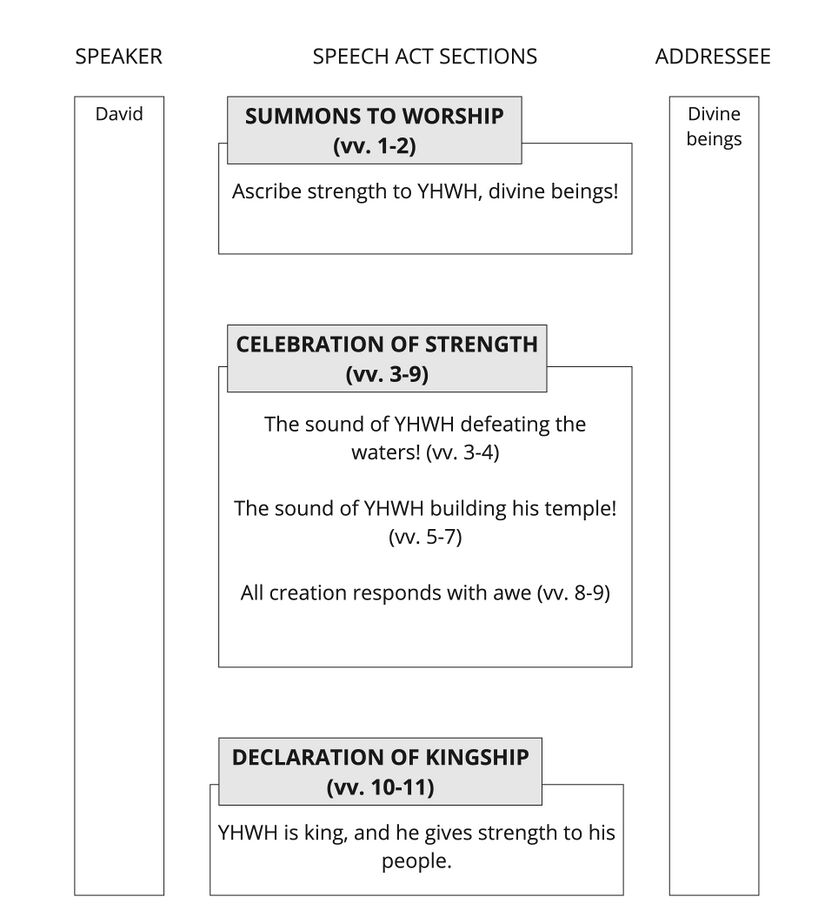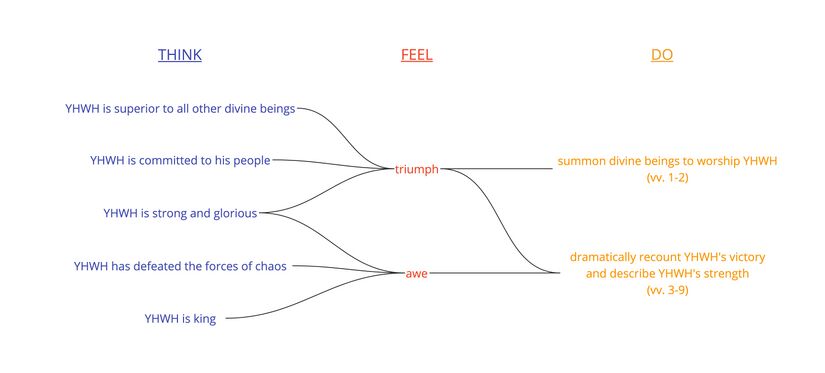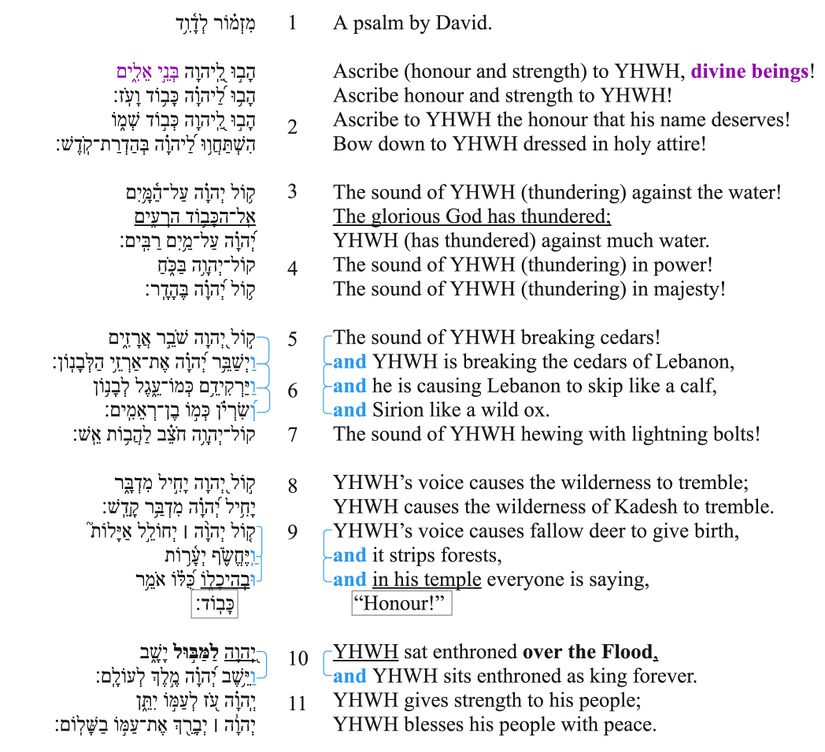Psalm 29 Discourse
From Psalms: Layer by Layer
Macrosyntax
| Macrosyntax legend | |
|---|---|
| Vocatives | Vocatives are indicated by purple text. |
| Discourse marker | Discourse markers (such as כִּי, הִנֵּה, לָכֵן) are indicated by orange text. |
| The scope governed by the discourse marker is indicated by a dashed orange bracket connecting the discourse marker to its scope. | |
| The preceding discourse grounding the discourse marker is indicated by a solid orange bracket encompassing the relevant clauses. | |
| Subordinating conjunction | The subordinating conjunction is indicated by teal text. |
| Subordination is indicated by a solid teal bracket connecting the subordinating conjunction with the clause to which it is subordinate. | |
| Coordinating conjunction | The coordinating conjunction is indicated by blue text. |
| Coordination is indicated by a solid blue line connecting the coordinating clauses. | |
| Coordination without an explicit conjunction is indicated by a dashed blue line connecting the coordinated clauses. | |
| Marked topic is indicated by a black dashed rounded rectangle around the marked words. | |
| The scope of the activated topic is indicated by a black dashed bracket encompassing the relevant clauses. | |
| Marked focus or thetic sentence | Marked focus (if one constituent) or thetic sentences[1] are indicated by bold text. |
| Frame setters[2] are indicated by a solid gray rounded rectangle around the marked words. | |
| [blank line] | Discourse discontinuity is indicated by a blank line. |
| [indentation] | Syntactic subordination is indicated by indentation. |
| Direct speech is indicated by a solid black rectangle surrounding all relevant clauses. | |
| (text to elucidate the meaning of the macrosyntactic structures) | Within the CBC, any text elucidating the meaning of macrosyntax is indicated in gray text inside parentheses. |
If an emendation or revocalization is preferred, that emendation or revocalization will be marked in the Hebrew text of all the visuals.
| Emendations/Revocalizations legend | |
|---|---|
| *Emended text* | Emended text, text in which the consonants differ from the consonants of the Masoretic text, is indicated by blue asterisks on either side of the emendation. |
| *Revocalized text* | Revocalized text, text in which only the vowels differ from the vowels of the Masoretic text, is indicated by purple asterisks on either side of the revocalization. |
- Paragraph divisions. In this Psalm, most of the paragraphs may be delimited according to the distribution of verbal forms.
- vv. 1-2. Imperatives
- vv. 3-4. Lack of verbs; the only verb in this paragraph is הִרְעִים (v. 3b), and in the remaining clauses, this verb is either gapped (as in v. 3c) or the action denoted by the verb (thundering) is implied (v. 3a, 4ab).
- vv. 5-7. Participles frame this section (vv. 5a, 7). Every clause that does not have a participle begins with waw (vv. 5b, 6ab), such that it is joined to a clause (or group of clauses) that does have a participle.
- vv. 8-9. Yiqtol verbs characterise this section (vv. 8ab, 9a). As in the previous section, every clause that does not have a yiqtol begins with waw (vv. 9bc), such that it is joined to a clause (or group of clauses) which does have a yiqtol. Also supported this section division is the shift from sentence fragments (vv. 3-7) to complete sentences with finite verbs.
- vv. 10-11. This final paragraph is bound together, not by verbal morphology, but by the repetition of YHWH's name in clause-initial position (vv. 10a, 11ab). The only clause in which YHWH is not clause-initial is a wayyiqtol clause (v. 10b).
- vv. 1-2. In vv. 1b-2a, the indirect object (לַיהוָה) precedes the direct object (cf. Ps. 96:7=1 Chron 16:28). This may be explained by the fact that לַיהוָה is shorter than the coordinated phrase כָּב֥וֹד וָעֹֽז (v. 1b) and the construct phrase כְּב֣וֹד שְׁמ֑וֹ (v. 2a). "Long constituents tend to occur at the end of a clause" (BHRG 46.1.3.1). Contrast e.g., Deut. 32:3, in which the indirect object is longer than the direct object and so occurs last in the clause – הָב֥וּ גֹ֖דֶל לֵאלֹהֵֽינוּ. Lunn (2006:301) also regards the word order in Ps. 29:1-2 as "canonical."
- v. 3b. Lunn (2006:301) regards the S-V order of this clause as pragmatically marked, though he does not specify in what sense it is marked.
- Option 1: אֵל־הַכָּבוֹד is in marked focus. "Who thundered against the water? Not the inglorious Baal, but YHWH who is 'the God of glory.'"
- Option 2: the whole sentence is in focus. The previous line ("The sound of YHWH...!") raises the question, "what just happened?" and v. 3b answers that question: "the glorious God has thundered."
- vv. 8a, 9a. Lunn (2006:301) regards these clauses as pragmatically marked. It seems more likely, however, that they are fronted in order to match the other instances of קוֹל יְהוָה which are necessarily clause initial (vv. 3a, 4ab, 5a, 7) by virtue of the fact that they are exclamations (cf. 1 Kgs. 18:41; Ct. 2:8; 5:2; Isa. 66:6; cf. JM §162e).
- v. 9c. The fronted PP (marked topic) shifts the scene from the forest to YHWH's temple.
- v. 10. Lunn (2006:301) regards the word order of the clause in v. 10a as "defamiliarized" and the clause in v. 10b as "canonical." He claims that the function of this DEF//CAN parallelism is to mark the beginning of a new section ("aperture") (Lunn 2006:161).
- v. 11. The subject precedes the verb in both 11a and 11b, not because the subject is marked for topic or focus, but because the verbs are indicative. If the yiqtol verbs were clause-initial, then they would be interpreted as jussives. Lunn (2006:301) categorizes the word order in both clauses of v. 11 as "defamiliarized" and suggests that they function to mark "closure" (2006:176).
- v. 11a. The verb final position of יִתֵּן in v. 11a (S O lamed-PP V) may be intended to match v. 10a (S lamed-PP V). For similar word order, see Ps. 72:1 (O IO V) – אֱֽלֹהִ֗ים מִ֭שְׁפָּטֶיךָ לְמֶ֣לֶךְ תֵּ֑ן.
Speech Act Analysis

For Visual, click "Expand" to the right
Affect Analysis

For Visual, click "Expand" to the right
- ↑ When the entire utterance is new/unexpected, it is a thetic sentence (often called "sentence focus"). See our Creator Guidelines for more information on topic and focus.
- ↑ Frame setters are any orientational constituent – typically, but not limited to, spatio-temporal adverbials – function to "limit the applicability of the main predication to a certain restricted domain" and "indicate the general type of information that can be given" in the clause nucleus (Krifka & Musan 2012: 31-32). In previous scholarship, they have been referred to as contextualizing constituents (see, e.g., Buth (1994), “Contextualizing Constituents as Topic, Non-Sequential Background and Dramatic Pause: Hebrew and Aramaic evidence,” in E. Engberg-Pedersen, L. Falster Jakobsen and L. Schack Rasmussen (eds.) Function and expression in Functional Grammar. Berlin: Mouton de Gruyter, 215-231; Buth (2023), “Functional Grammar and the Pragmatics of Information Structure for Biblical Languages,” in W. A. Ross & E. Robar (eds.) Linguistic Theory and the Biblical Text. Cambridge: Open Book Publishers, 67-116), but this has been conflated with the function of topic. In brief: sentence topics, belonging to the clause nucleus, are the entity or event about which the clause provides a new predication; frame setters do not belong in the clause nucleus and rather provide a contextual orientation by which to understand the following clause.


